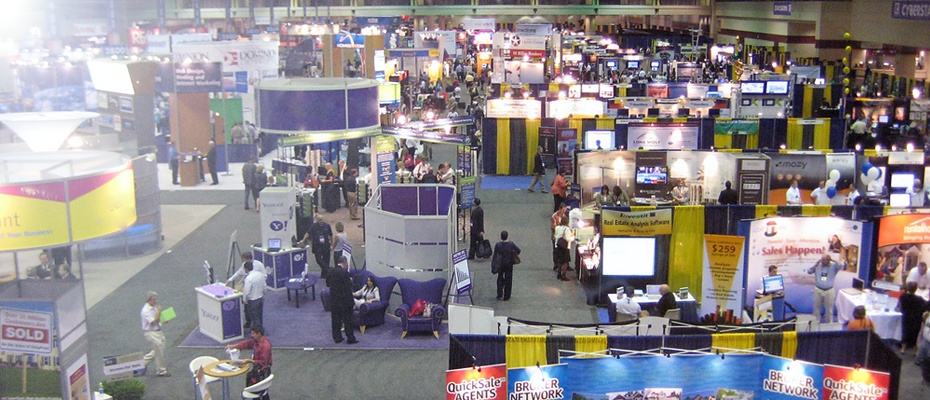
The interest in trade show marketing increased significantly in the last decade. Forecasts and analysis show a further expansion of the trade fair industry in major economic hubs in Europe and the USA and a rise in the Middle East and Asia.
To present their business to potential customers at conferences, expositions and industry-related events, marketers use various displays, banners, stands and booths. These have to both visual appeal to and interact with visitors while being easy to assemble and transport.
This article will introduce you to the most popular types of displays used in the industry today. Depending on your budget, target audience, objectives and preferences, you can choose any of the options available or combine them to get the best value for money.
Difference Between a Stand, a Booth, an Exhibit and a Display
Although sometimes used interchangeably these terms have their own specific meaning. It is important to know the differences between them when you are preparing to attend a trade fair. Especially if it is some huge event like CPHI Worldwide, Medica, Anuga, IFA, Prowein, Biofach, etc. Here is the difference:
Exhibition Stand - According to the Cambridge dictionary, it is described, as “a section of an exhibition where a particular company shows their products or information about their products.”
Exhibition Booth - It is the physical construction used to host the exhibitors and their inventory. If we dive once again into the Cambridge dictionary, this explanation pops-up ”a partly closed area or small tent at a fair, exhibition, or similar event.”
Exhibit - It referred to the items/products you want to showcase and present to your audience. Think about models, display products and testers. The emphasis falls on the objects you wish to show, not on the whole installation.
Exhibition Display - The Cambridge dictionary explains it as “a collection of objects or pictures arranged for people to look at, or a performance or show for people to watch.” A display is the whole show, with all of its promotion materials, banners, lighting, etc.
NB : Booth and stand are casually used to describe the same thing. The difference is the latter is used primarily in Europe. We will use the term booth accompanied by the proper explanation, to avoid confusion.
Booth Configurations
In each exhibition hall, there are different ways of organising the booth spaces. Depending on the price you are ready to pay, you can choose from the following options.
Inline Booths
In this configuration, the booths are placed in a line next to each other with barriers between them. This way, you end up with 3 walls on which you could put shelves to exhibit your products or hang eye-catching banners. The downside of this type is you receive traffic from only one way which can cause quite a commotion during the busiest hours.

Corner Booth
These booths have two openings to the aisles and provide more space both for foot traffic and presentations. Since it's located on an intersection, corner booths are the desired location, thus they are a little more expensive. However, the exhibitors can feel “lost” in the crowd, and they need to put a lot of effort to stand out.

Peninsula Booth
They have 3 sides open towards the aisles, and a shared back. The layout allows the free passage of visitors and gives the opportunity to put on various displays and banners. The place doesn't feel claustrophobic, and the exhibitors have enough open space to showcase their product to a larger crowd. Peninsulas are usually twice the size of corner booths. The only negative is the lack of space to put shelves, store or exhibit your goods.

Split-Island Booth
This configuration is similar to the corner booth. However, you will only have one other neighbouring exhibitor. This means you can attract more visitors and put up a memorable presentation. The split-island booth is larger in size, and you will need to carefully plan your displays, storage and manpower.
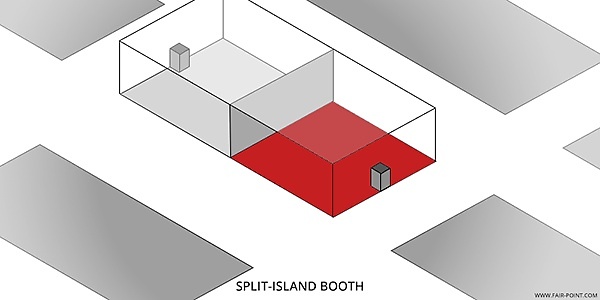
Island Booth
The most expensive of all configurations, this one allows you to dominate your area of the exhibition. Open from all sides it stands alone, surrounded by aisles and crowds. Keep in mind, the more free space you have, the more stuff you will need to service the booth. The expenses for banners, displays and promo materials are also higher.
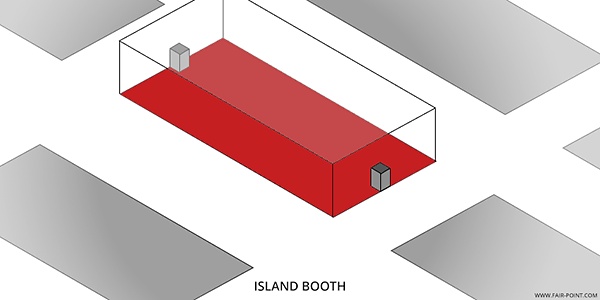
Standard Booth Sizes
Exhibition spaces come in different dimensions depending on the type and location of the event. Availability and price are also a major factor. However, a couple of sizes are accepted as an industry standard for trade shows.
3m x 3m (10’ x 10’) Booth Size
It is the most popular size of all, and the only one, many trade fairs can offer to their exhibitors. The configuration of the booths is usually inline or corner. It is important to know the layout beforehand, so you can properly plan and prepare. As a rule of thumb, displays must be made smaller than the size of the booth. This way, you can fit everything.
3m x 6m (10’ x 20’) Booth Size
Usually, booths of this size have a peninsula configuration. It is always 6m wide and 3m deep. You receive extra space for displays and have a bigger chance to impress your audience. Their price is a little bit higher, but the expenses are worth it.
6m x 6m (20’ x 20’) Booth Size
Here we are talking about island booths - the biggest and most expensive of all. The size permits you to have a big crew and provides enough storage and display space. The design and dimensions of these booths allow you to have a high visual impact on your audience.
Types of Booths, Stands and Displays
A trade show display has to be created with regards to the target audience and needs to maintain low transport, assemble and disassemble cost. Depending on what each is made from and how it is put together there are different types of structures you can use.
Pipe and Drape Booths
The pipe and drape booths are made from connecting hollow metal or plastic tubes at the corners. Fabric drapes are suspended along the poles to provide a visual distinction between the exhibitors at the event. Combined with other forms of display advertising and banners directly hung along with the structure, this type of trade show booth provides various options to represent your business.

Panel and Frame Booths
The booths use a set of panels connected via a frame. It is the most popular display in the trade show and event industry due to the various uses it offers. A panel and frame booth provides a freestanding room which can bring into play screens, banners and live demonstrations. These booths require transport and assemblage by a contractor that has to be approved by the event organisers.

Pop-Up Trade Show Displays
The pop-up display utilises a graphic panel with a light framework. It is easy to carry and assemble. The graphic display is interchangeable, as different panels can be attached to the framework without difficulty. These pop-ups are used to both:
- direct the visitors’ interest to the exhibitor’s main trade show display;
- on their own in a chain for a product or service advertisement.

Banner/Screen Stands
Banner stands are similar to the pop-ups but utilise a single standing frame instead. They provide a bigger display area which can be used for indoor and outdoor events alike. Due to the increased availability, screen stands are getting popular in the trade show marketing industry. These employ TV and LED screens to show advertisements or demonstration videos. These heavy-duty frames are harder to assemble and transport due to their size.
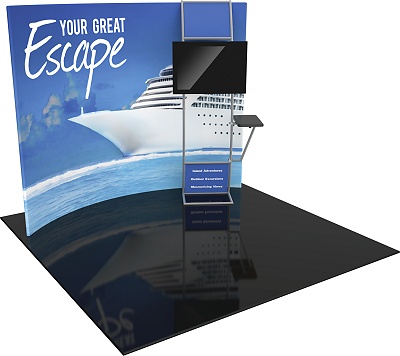
Tension Fabric Displays
Tension fabric displays are constructed from aluminium poles and large textile sheets that are stretched on them. This way, you can create an eye-catching wall and attach different monitors, lighting or shelves. Tension fabric systems are easy to put together and transport. The elements are not heavy, which is perfect if you have to move the construction. The way the systems are set up depends on the manufacturer so before you make your purchase check to see if it is suitable for your needs.

Tabletop and Table Covers
Tabletops and covers are the most basic type of trade show displays. Different graphics or vinyl banners are placed on a foldable frame, converting the table into a billboard advertisement for the business. The standard tabletop frameworks are often provided by the trade fair organisers, upon a request. Current best practices show the display’s height should revolve around the average eye height - between 160 and 170 cm (65 inches). This type of arrangement is most suitable for small-scale events due to its basic design and limited functionality.
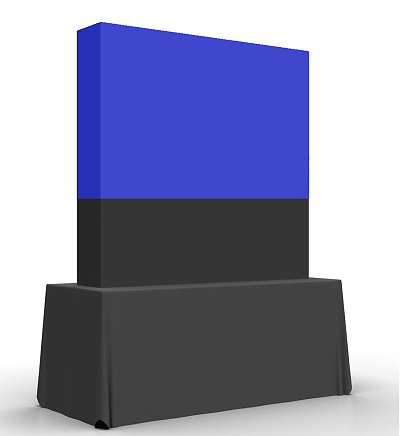
Hybrid Displays
These modern-looking displays are a combination of different elements - panels, counters, banners, etc. You can create your own custom arrangement to set you apart from your competitors. Hybrids are portable, relatively easy to set up and fit in almost every type of booth. As a bonus, they are not that expensive. In the last years, these types of displays have outshined the pop-ups, and are now the most wide-spread and preferred option.
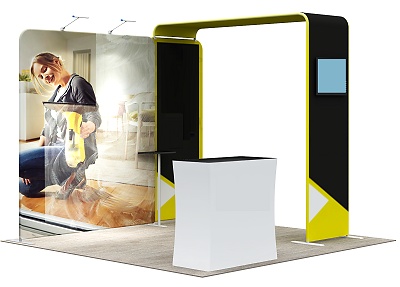
Truss
If you are searching for flexibility and a variety of design options, the truss systems are the right way to go. From hanging displays to custom booths, you can have it all. Hanging stage lights, shelves, counters, podiums are just some of the things you can add. The aluminium framework comes in different colours and graphics. Depending on what you want, you may need professional help setting up the system, but better safe than sorry.
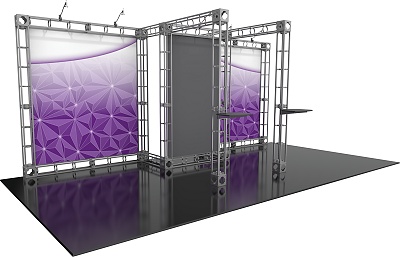
Are you ready for your next trade show? If you want to lower your costs, don’t compromise with your booth and displays. Instead, rely on a trustworthy partner to organise your business accommodation and save you some money. Fair Point can offer you great deals on hotel bookings for your business trip and protect your interests with a specially designed cancellation policy.
Wie können wir behilflich sein?
Sind Geschäftsreisekosten steuerlich absetzbar?
Was macht ein Reisebüro?
Ist es günstiger, ein Reisebüro zu beauftragen?